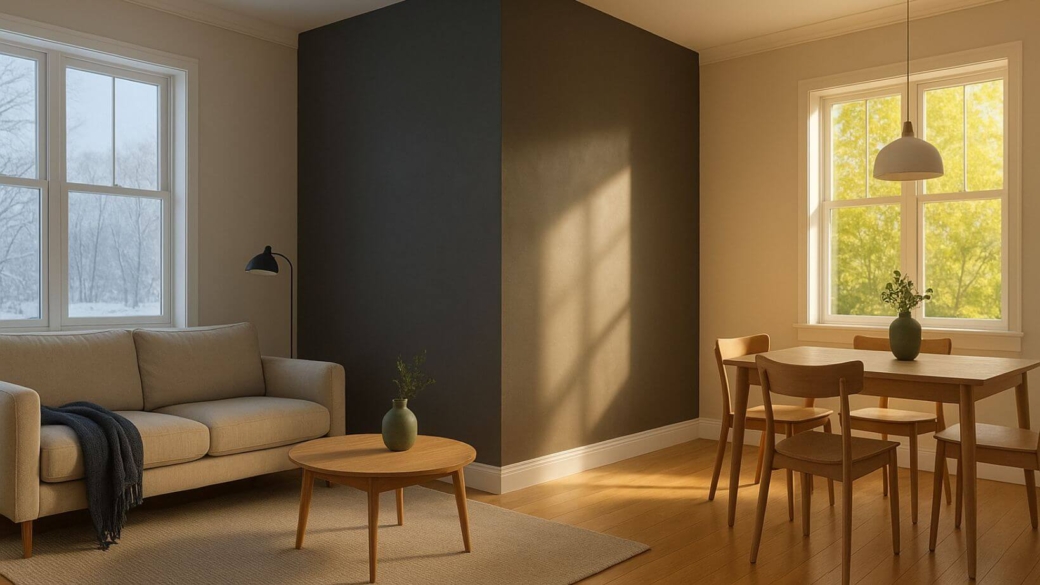The living room is an essential part of a property and one that sets the tone for the rest of the home.
If you’re a landlord looking to increase rent prices, enhancing the interior of your living room is a great place to start.
Tenants expect a reliable bathroom, a functioning kitchen, and comfortable sleeping arrangements. But without a warm and welcoming living room, they will turn their attention elsewhere.
Read on to find out how to upgrade the interior of your property’s living space.
Paint The Walls A Neutral Colour
Finding the right colour scheme for your living room is key. Realistically, you can’t repaint and decorate the room for every new tenant depending on their preferences, so choosing neutral colours is your best bet.
Choose a shade of beige or grey, or even a muted blue or green to provide a calm and welcoming environment.
Hiring a painter & decorator typically costs around £400-£450, whereas the price of DIY painting will come to around £200.
If you’re completing the paint work yourself:
- Clean the walls and repair any holes. Sand rough areas and ensure the surface is dry before you begin painting.
- Use primer if the walls are new, stained, or you’re switching from a dark colour to a light colour.
- Use even strokes and apply several thin coats rather than one thick one. Start with edges and corners and move from top to bottom.
Install Premium Skirting
A living room with poorly fitted and low quality skirting boards can deter potential occupants from looking further at your freshly painted walls, cosy fireplace, and bay windows.
Often overlooked, skirting is an essential part of creating a homely room. When fitted correctly, they frame the room, complementing the base colour and protect the walls from inevitable scuffs and furniture knocks.
Source high quality timber skirting boards in order to ensure longevity and enhance the aesthetic appeal and functionality of the living room.
Installing strong skirting boards around the entire room will typically cost in the region of £250-£350.
When fitting, remember to:
- Measure the walls and cut the skirting boards to the right size for neat corner joints.
- Use adhesive and nails to attach the boards to the wall.
- Fill in any gaps and nail holes and sand and paint the boards for a tidy finish.
Light The Room Up
Generally speaking, tenants don’t want to come home from a hard day’s work to spend their evening in a dingy living room.
Don’t just offer them a ceiling light, as that sometimes isn’t enough, particularly in larger areas.
Put a couple of smaller lamps around the room to increase the overall brightness.
Naturally, light bulbs eventually burn out. If you are using standard options like incandescent bulbs, you may find yourself needing to replace them every six months or so.
Incandescent bulbs typically cost around £2-£3, while you could buy a strong LED alternative for £5-£10.
LED light bulbs are a far better long-term solution. Let’s break it down:
- An incandescent light bulb has a typical lifespan of 1000 hours, whereas LED light bulbs have a lifespan of 25,000-50,000 hours.
- While LED bulbs are more expensive up front, they use far less electricity and save tenants money, or landlords if bills are included.
Hang A Mirror On The Wall
A mirror also acts as a natural light enhancer. When the sun comes through the window, a mirror helps to reflect the light throughout the room. Place it directly opposite the window to maximise the reflection.
They also give the illusion of a much larger living room, which is definitely useful if you’re looking to charge higher prices.
You could also consider adding some paintings or pictures that will also add some identity to the living area. But remember, less can be more, so don’t cram the room with either.
Source a mirror that has style and blends in well with the overall interior. Finding a quality one should only set you back around £100 but you could find a good second hand substitute for less than half of that.
Roll Out A Rug
This is another simple enhancer, but a massively effective one that adds visual appeal.
Rugs can also help with insulation during colder parts of the year, keeping tenants warm and reducing the need for as much heating.
Even high-functioning rooms can look bare and bland. Rugs add character and generally make the living space feel more welcoming.
You can generally source a good standard one for £200.
Things to bear in mind:
- Stains will be less prominent on darker rugs, making them a more suitable long-term option.
- Find a rug that fits the space you are trying to cover without posing tripping hazards,
- You can add anti-slip pads underneath the rug for safety.
Conclusion
There are various ways you can enhance your living room’s interior to increase the value of your rental property.
We have listed five effective ways of doing so that don’t break the bank, but do help bump up rates and increase profitability in the long run.
Start upgrading your living area today and remember to source good materials and complete the job properly.


